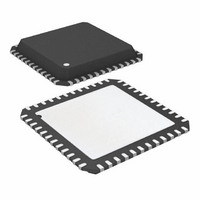AD7631BCPZ Analog Devices Inc, AD7631BCPZ Datasheet - Page 20

AD7631BCPZ
Manufacturer Part Number
AD7631BCPZ
Description
IC,A/D CONVERTER,SINGLE,18-BIT,CMOS,LLCC,48PIN
Manufacturer
Analog Devices Inc
Series
PulSAR®r
Datasheet
1.AD7631BSTZ.pdf
(32 pages)
Specifications of AD7631BCPZ
Number Of Bits
18
Sampling Rate (per Second)
250k
Data Interface
Serial, Parallel
Number Of Converters
1
Power Dissipation (max)
120mW
Voltage Supply Source
Analog and Digital
Operating Temperature
-40°C ~ 85°C
Mounting Type
Surface Mount
Package / Case
48-VFQFN, CSP Exposed Pad
Lead Free Status / RoHS Status
Lead free / RoHS Compliant
AD7631
The four diodes, D1 to D4, provide ESD protection for the analog
inputs, IN+ and IN−. Care must be taken to ensure that the analog
input signal never exceeds the supply rails by more than 0.3 V,
because this causes the diodes to become forward-biased and to
start conducting current. These diodes can handle a forward-
biased current of 120 mA maximum. For instance, these conditions
could eventually occur when the input buffer’s U1 supplies are
different from AVDD, VCC, and VEE. In such a case, an input
buffer with a short-circuit current limitation can be used to protect
the part although most op amps’ short-circuit current is <100 mA.
Note that D3 and D4 are only used in the 0 V to 5 V range to
allow for additional protection in applications that are switching
from the higher voltage ranges.
This analog input structure of the AD7631 is a true differential
structure allowing the sampling of the differential signal between
IN+ and IN−. By using this differential input, small signals
common to both inputs are rejected, as shown in Figure 29,
which represents the typical CMRR over frequency.
During the acquisition phase for ac signals, the impedance of
the analog inputs, IN+ and IN−, can be modeled as a parallel
combination of Capacitor C
the series connection of R
capacitance. R
comprised of serial resistors and the on resistance of the switches.
C
the input range selected, is typically 48 pF in the 0 V to 5 V range,
typically 24 pF in the 0 V to 10 V and ±5 V ranges, and typically
12 pF in the ±10 V range. During the conversion phase, when the
switches are opened, the input impedance is limited to C
Because the input impedance of the AD7631 is very high, it can
be directly driven by a low impedance source without gain
error. To further improve the noise filtering achieved by the
AD7631 analog input circuit, an external, one-pole RC filter
between the amplifier’s outputs and the ADC analog inputs
can be used, as shown in Figure 27. However, large source
impedances significantly affect the ac performance, especially
the THD. The maximum source impedance depends on the
IN
is primarily the ADC sampling capacitor and, depending on
120
100
80
60
40
20
0
1
0V TO 5V
Figure 29. Analog Input CMRR vs. Frequency
IN
is typically 5 kΩ and is a lumped component
±10V
10
0V TO 10V
FREQUENCY (kHz)
IN
PIN
and C
and the network formed by
100
IN
. C
PIN
±5V
is primarily the pin
1000
10000
PIN
.
Rev. A | Page 20 of 32
amount of THD that can be tolerated. The THD degrades as a
function of the source impedance and the maximum input
frequency, as shown in Figure 30.
DRIVER AMPLIFIER CHOICE
Although the AD7631 is easy to drive, the driver amplifier must
meet the following requirements:
•
•
f
–3dB
For multichannel, multiplexed applications, the driver
amplifier and the AD7631 analog input circuit must be
able to settle for a full-scale step of the capacitor array
at a 18-bit level (0.0004%). For the amplifier, settling at
0.1% to 0.01% is more commonly specified. This differs
significantly from the settling time at a 18-bit level and
should be verified prior to driver selection. The
amp combines ultralow noise with high gain bandwidth and
meets this settling time requirement even when used with
gains of up to 13.
The noise generated by the driver amplifier needs to be
kept as low as possible to preserve the SNR and transition
noise performance of the AD7631. The noise coming from
the driver is filtered by the external, 1-pole, low-pass filter,
as shown in Figure 27. The SNR degradation due to the
amplifier is
Figure 30. THD vs. Analog Input Frequency and Source Resistance
where:
V
–110
–130
–70
–90
NADC
is the cutoff frequency of the input filter (3.9 MHz).
0
V
SNR
20
is the noise of the ADC, which is
NADC
log
LOSS
⎛
⎜
⎜
⎜
⎜
⎝
=
=
V
2
10
NADC
25
V
2
INp-p
200Ω
100Ω
SNR
33Ω
20
15Ω
2
2
FREQUENCY (kHz)
+
π
2
f
−
50
3dB
(
V
Ne
NADC
N
+
)
2
+
75
π
2
f
−
AD8021
3dB
(
Ne
100
N
−
op
)
2
⎞
⎟
⎟
⎟
⎟
⎠












